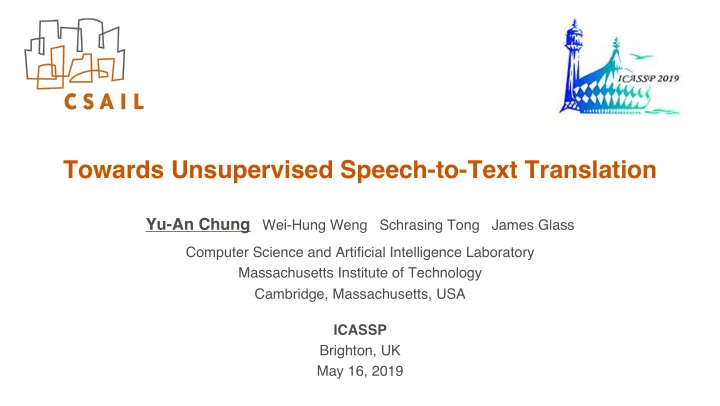

Towards Unsupervised Speech-to-Text Translation Yu-An Chung Wei-Hung Weng Schrasing Tong James Glass Computer Science and Artificial Intelligence Laboratory Massachusetts Institute of Technology Cambridge, Massachusetts, USA ICASSP Brighton, UK May 16, 2019
Outline • Motivation • Proposed Framework • Experiments • Conclusions
Outline • Motivation • Proposed Framework • Experiments • Conclusions
Machine Translation (MT) Training data pairs English French ( , ) “the cat is black” MT system “le chat est noir” text translation Automatic Speech Recognition (ASR) English English ( , ) “dogs are cute” ASR system transcription audio Text-to-Speech Synthesis (TTS) English English ( , ) TTS system “cats are adorable” audio text Paired data are expensive, but unpaired data are cheap.
Outline • Motivation • Proposed Framework • Experiments • Conclusions
Proposed Framework • Goal: Build a speech-to-text translation system using only unpaired corpora of speech (source) and text (target) • Steps at a high-level – Word-by-word translation from source to target language * Unsupervised speech segmentation for segmenting utterances into word segments * Mapping word segments from speech to text – Improve the word-by-word translation results leveraging prior knowledge on target language * Pre-trained language model * Pre-trained denoising sequence autoencoder
Word-by-Word Translation Training Do not need to be parallel. Testing “le chat est noir” French audio corpus English text corpus Wikipedia is a multilingual, web-based, free encyclopedia based on a model of openly editable and viewable content, a wiki. It is the largest and most popular … Speech2vec Word2vec [Chung & Glass, 2018] [Mikolov et al., 2013] x $ ( x % ∈ ℝ +×' X = ⋮ x ' y $ ( VecMap y % [Artexte et al., 2018] ∈ ℝ +×' Y = ⋮ y ' + Nearest neighbor search Learn a linear mapping W such that W ∗ = argmin W ∈ℝ 7×7 WX WX − Y 9 “the” “cat” “is” “black”
Pre-Trained Language Model • Word-by-word translation results are not good enough – Nearest neighbor search does not consider the context of a word * Hubness problem in a high-dimensional embedding space * Correct translation can be synonyms or close words with morphological variations • Language model for context-aware beam search – Pre-trained on a target language corpus – To take contextual information into account during the decoding process (search) * " # : the word vector mapped from the speech to the text embedding space * " $ : the word vector of a possible target word * The score of " $ being the translation of " % is computed as: Nearest neighbor search Language model &'()* " # , " , = log cos " # , " , + 1 + 6 78 log 9 " , |ℎ 2
Denoising Sequence Autoencoder • Goal: To further improve the translation outcome from the previous step – Multi-aligned words – Words in wrong orders • Denoising autoencoder – Pre-trained on a target language corpus – During training, three kinds of artificial noises were added to a clean sentence and the autoencoder was asked output the original clean sentence: * Insertion noise “Listen to me” “Dance with me” * Deletion noise Denoising Denoising * Reordering noise “Listen me” “Dance me with” Word-by-word translation Word-by-word translation + French French + LM search LM search sentence #1 sentence #2
Outline • Motivation • Proposed Framework • Experiments • Conclusions
Setup • Data: LibriSpeech English-to-French speech translation dataset 1 – English utterances (from audiobooks) paired with French translations * Speech embedding space: train Speech2vec on the train set speech data (~100 hrs) * Text embedding space: train Word2vec on the train set text data vs. crawled French Wikipedia corpus • Framework components: 1) Word-by-word translation * VecMap 2 to learn the mapping from speech to text embedding space 2) Language model for context-aware search * KenLM 5-gram count-based LM trained on the crawled French Wikipedia corpus 3) Denoising sequence autoencoder * 6-layer Transformer trained on the crawled French Wikipedia corpus 1 Augmenting LibriSpeech with French translations: A multimodal corpus for direct speech translation evaluation. Kocabiyikoglu et al. 2018 2 A robust self-learning method for fully unsupervised cross-lingual mappings of word embeddings. Artetxe et al. 2018
Setup • Supervised baselines – Cascaded systems * Speech recognition + machine translation pipeline (individually trained) – End-to-end (E2E) systems * A single sequence-to-sequence network w/ attention trained end-to-end • BLEU scores (%) on the test set (~6 hrs) were reported – Both the best and avg. over 10 runs from scratch
Results Observations: 1. LM and DAE boost translation performance: (e) vs. (f) vs. (g) 2. Domain mismatch affects the alignment quality: (e) vs. (h) 3. Our unsupervised ST is comparable with supervised baselines: (a) ~ (d) vs. (g) and (i) Unpaired corpora setting
Outline • Motivation • Proposed Framework • Experiments • Conclusions
Conclusions and Future Work • An unsupervised speech-to-text framework is proposed – Relies only on unpaired speech and text corpora * Word-by-word translation * Context-aware language model * Denoising sequence autoencoder – Achieved comparable BLEU scores with supervised baselines * Cascaded systems (ASR + MT) * End-to-end systems (Seq2seq + attention) • Improve the alignment quality • Apply to low-resource languages • Extend the framework to other sequence transduction tasks (e.g., ASR, TTS)
Thank you! Questions?
Recommend
More recommend